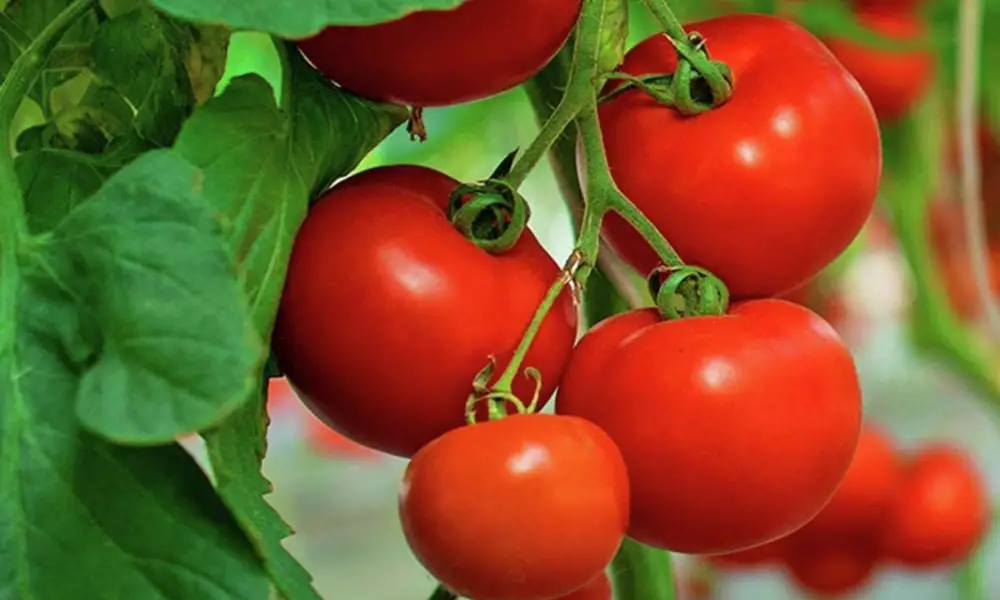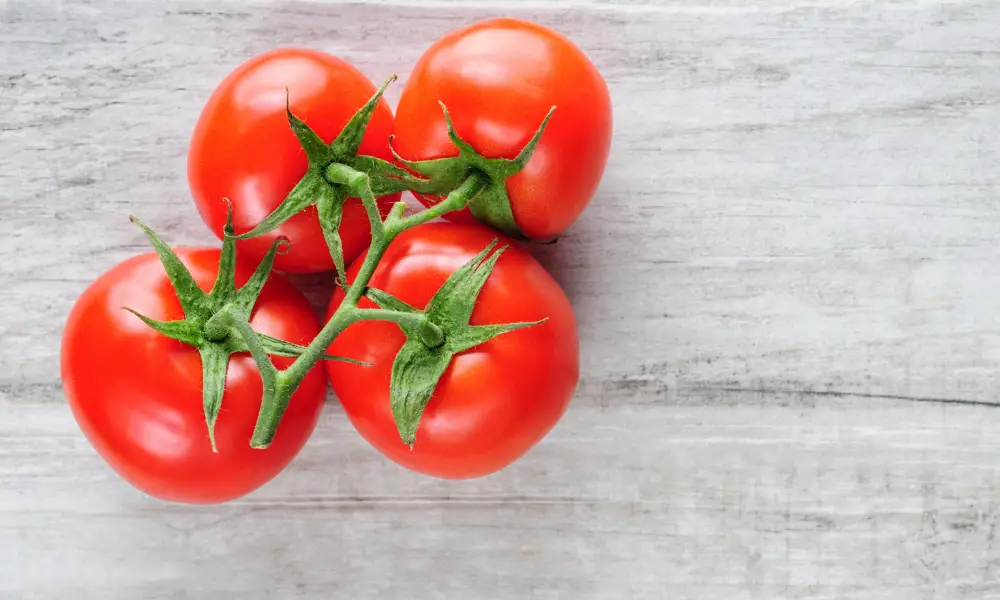To preserve tomatoes, I like to dehydrate them in my dehydrator. But peeling, slicing, and drying them all take time. Therefore, I shall freeze my garden’s abundant supply of tomatoes when I feel sluggish to preserve them.
It only takes a few minutes to freeze tomatoes, and the process is straightforward. I choose a few very ripe tomatoes. I think to use good and fully ripe tomatoes to achieve the best tomato flavour. Typically, I harvest my tomatoes, bring them inside, and let them ripen in a bowl on my counter.

Can Tomatoes be Frozen?
Absolutely! The best time to find fresh garden tomatoes at farmers’ markets, pick-your-own farms, or harvest ones you have grown yourself is from June to September. Choose firm tomatoes with deep colours when choosing tomatoes to freeze. They have to be spotless, substantial for their size, and aromatic. When palm pressure is applied, perfectly ripe tomatoes will give slightly. We’ll show you how to freeze extra garden tomatoes so you can store them for later months. We’ll also advise you to freeze whole tomatoes and tomatoes without blanching.
The majority of tomato varietals can be frozen. The finest results, however, will be obtained using plum (Roma) tomatoes because they have the most pulp. Store your tomatoes at room temperature if you don’t intend to freeze them immediately. Avoid putting fresh tomatoes in the fridge since they could lose their flavour and turn mealy.
How to Freeze Few Tomatoes?
This technique can freeze one tomato or as many as will fit in a single layer in a sealable plastic bag. Put the tomatoes inside the bag in a single layer. You can use a straw to do this if you’d like. After sealing the bag, suck out as much air as possible. The tomatoes should remain in a single layer and not be crushed together as you place the bag in the freezer. Seal it. Move the bag only once the tomatoes have frozen. After being frozen, they can be bundled up to take up less room.
During the tomato season, you may also freeze extra fruits using the same method, one at a time. Keep a bag of frozen tomatoes that isn’t quite full in the freezer, and add tomatoes that you can’t consume quickly enough. As more tomatoes arrive in the kitchen but aren’t consumed, add them. Ensure that the fresh fruits are frozen in a single layer.
How to Quickly Freeze a Large Number of Tomatoes?
- When freezing a large number of tomatoes, freezing them on a cookie sheet first may be more effective than packaging them in bags.
- The fruits in the middle of a bag of frozen fruit wouldn’t freeze as quickly as the fruits on the exterior, and the quicker something freezes, the better.
- Put tomatoes in a single layer on a baking sheet and freeze them completely for a few hours before transferring them into bags to ensure they freeze as quickly and evenly as possible. To maintain freshness, use the bag technique to remove as much air as possible before sealing the bag.
How to Use Frozen Tomatoes in Soups?
If you want to save time, one way to make your tomato soup is to use frozen tomatoes. Chopped frozen tomatoes can be added to hearty stews or light soups, and they can be added after cooking and blend well with other ingredients. Peeled and diced frozen tomatoes can replace fresh tomatoes in gazpacho soup. To add the full taste of a tomato soup, thaw the frozen tomatoes before adding to the soup.
You can use frozen tomatoes for cooking in the winter months; they are easy to store and don’t take up much room. You can also use them in soups, stews, or chilli. Make sure you don’t use them in tomato salsa, as they have a slightly drier taste than fresh tomatoes. Half to the quarter-pound piece is enough for tomato salsa. To enjoy fresh-tasting tomatoes in winter, freeze them as you would fresh.
Do the Tomatoes Need to be Peel for Freezing?
You don’t need to peel tomatoes before freezing them; once they’re frozen, the skins fall off. However, you can certainly peel your tomatoes before freezing if you choose. Similarly, you might choose not to remove the seeds from the tomatoes after cutting them in half. The real choice is whether to complete the assignment now or later.
Before they are frozen, some home cooks think that tomatoes that have been peeled and deseeded retain a somewhat better texture. However, the difference is negligible enough that, depending on how you want to use them, you could continue to freeze them whole and deal with any peel or seeds afterwards.
What are the Ways of Using Frozen Tomatoes?
Although frozen tomatoes will still taste just like fresh tomatoes, their texture won’t be suitable for usage raw. So a Caprese salad isn’t the greatest course of action. A recipe that asks for preparing or processing fresh tomatoes, such as tomato sauce, soup, or puree, is the best place to use frozen tomatoes. Frozen tomatoes can also be used to make chilli or salsas and give colour and flavour to different kinds of soups and stews.
How Long will Frozen Tomatoes Last?
Keep the freezer’s temperature at 0°F or lower to guarantee proper freezing. For a year, tomatoes that have been frozen will retain their flavour. To utilize them in your preferred sauce, stew, or soup recipes, you have plenty of time to defrost them. When thawed, frozen tomatoes lose their firmness, so they work best in dishes that don’t call for them to be used raw, like marinara sauce. After being boiled down, your frozen tomatoes make a delicious winter treat.
What are the Health Benefits of Tomatoes?
Safeguards the Heart
Tomatoes, which are high in antioxidants, support the upkeep of healthy blood vessels. The presence of lycopene and vitamin C, two chemicals with antioxidant effects, improves blood flow and encourages the transit of oxygen in the blood.
Controls Blood Pressure
Antioxidants like lycopene, vitamin C, and others help to make the cardiovascular system healthier. But potassium also has a significant impact because it is a mineral that helps to control blood pressure.
Glowing skin
Regular tomato consumption helps to prevent acne, reduce enlarged pores, treat rashes and acne, and heal small burns.
Avoiding Eye Issues
Beta-carotenes, minerals that support eye health and lower the risk of cataract development, are present in tomatoes in addition to their high vitamin A and C content.
Decreases Inflammation
Since tomatoes contain anti-inflammatory substances like bioflavonoids and carotenoids, which in turn aid in reducing inflammation and soothe the pain of chronic conditions, regular consumption of tomatoes may have an anti-inflammatory effect.
Bone Wellness
Tomatoes are an ally for bone and dental health because they include calcium and vitamin K, which help to protect these conditions. Furthermore, vitamin K guards against osteoporosis.
Aids in preventing some cancers
Lycopene, vitamins A and C, and tomatoes all work together to lower the risk of stomach, prostate, and colorectal cancer.
For Longer Storage, How to Blanch Tomatoes?
A heat-and-cool process is blanching. Natural tomato enzymes that might lead to flavour and colour loss are stopped or slowed down by it. If tomatoes will be kept in your freezer for longer than a few months, blanch them first. Peeling tomatoes is made simple by blanching them first, which is the procedure.
Bring one gallon of water to a boil in a big 7 to 8-quart pot ($60, Bed Bath & Beyond).
Make a shallow X with a sharp knife on each tomato’s bottom. This causes the skin to crack during the blanching process, allowing you to easily peel the skin off the tomatoes once they have cooled.
Tomatoes should be added to the boiling water in 1-pound batches.
The tomato skins should start to split open after 1 to 2 minutes of cooking.
Transfer tomatoes to a sizable bowl of ice water using a slotted spoon.
What are the Advantages and Disadvantages of Freezing Tomatoes?
Advantages of Freezing Tomato
- The simplest method of preserving tomatoes is freezing, and it’s practical. It moves quickly, and they don’t require cooking. Tomatoes can be cleaned, their stems cut off, and placed in a freezer bag.
- In recipes, frozen tomatoes work wonderfully (sauces, casseroles, soups, stews, and chilli, for instance). Frozen tomatoes make sense for dishes where cooking is a requirement.
- Smaller amounts work. As the tomatoes ripen, you can freeze a few of the containers to prevent heating up the entire kitchen. (Considerable amounts are needed to fill jars and make canning worthwhile.) If you produce indeterminate tomatoes, which ripen seasonally rather than all at once like determinate tomatoes, this is extremely useful.
Disadvantages of Freezing tomatoes
- When thawed, tomatoes lose their firmness and become mushy. The pulp fibres stretch when they freeze and break down when they freeze because they contain water. The end effect is watery and squishy.
- Tomatoes lose flavour when frozen. Below 50oF, the flavour-producing enzymes in tomatoes are rendered inactive.
- Regarding texture, thawed tomatoes are not particularly tasty to consume on their own. (They are excellent for cooking but not so great for eating plain.)
- It takes up a lot of important freezer space to store frozen tomatoes. Canning might be the best option, depending on what you need to use that space for.
- When you harvest tomatoes, you can also “temporarily” freeze them whole. A month later, remove the tomatoes from the freezer, remove their skins under hot water, and process them in a hot water bath canner or a pressure canner.
How to Thaw Tomatoes?
To prepare tomato soup, freeze the soup several hours before you plan to use it. You can also reheat frozen soup in the microwave or on the stove. However, thawing is not recommended for soup containing cream, which can separate if it is added. To prevent this, stir the soup before you reheat it, which will prevent it from spoiling. Here are some tips to thaw frozen soup safely.
First, wash and cut off the cores from the tomatoes. Then, put them on a pan. Once frozen, you can place them in freezer-safe bags. Once frozen, tomatoes will retain their fresh flavour and low-calorie nutrition. Make sure to cook the soup within a week. Thawing tomatoes for soup is the perfect way to use them in winter. The recipe below uses a half or quarter-pound piece of frozen tomato.
Conclusion
There are several ways to freeze fresh, ripe tomatoes, including blanching them first and freezing them whole. Fortunately, you may freeze any tomato on the vine, including beefsteak, plum, and tomatoes. By blanching your tomatoes, you may keep them in a semi-liquid state that is ideal for soups, stews, and chilli. Additionally, the tomato’s flavour is preserved with this technique, reducing the risk of freezer burn.

